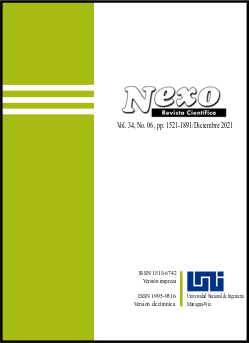Effect of cooking on the content of bioactive compounds in quinoa (Chenopodium quinoa Willd) of different varieties of Peru
DOI:
https://doi.org/10.5377/nexo.v34i06.13116Keywords:
Phenolic compounds, antioxidant activity, flavonoids, betacyanins, betaxanthinsAbstract
The objective was to determine the variability of the concentration of bioactive compounds in six samples of quinoa from Peru. The varieties ‘Blanca de Junín’, ‘Amarillo Maranganí’, ‘Pasankalla’, ‘Altiplano Lima’, ‘Negra Collana’, ‘Altiplano Puno’, which were provided by INIA, were evaluated. The selected samples were cooked (250g/500 ml of distilled water) for 30 min. Significant differences were observed by variety, condition, and the intersection of both by analysis of variance. Regarding the content of phenolic compounds, a significant difference was noted by variety: ‘Amarillo Maranganí’ had the maximum average (2.1287 GAE mg/g). There was a significant difference in antioxidant activity by variety: ‘Negra Collana’ had the maximum average (0.5161 mg GAE/g). There was also a significant difference in flavonoids by variety: ‘Altiplano Puno’ had the maximum average (0.6439 mg/g). For betacyanins there was a significant difference by variety and condition. ‘Altiplano Puno’ had a maximum average (0.5717 mg/100g), being different by variety, condition and both. Finally, ‘Altiplano Puno’ had the highest betaxanthin average (2.1125 mg/100g). Finally, there is evidence to affirm that cooking had an effect on the content of bioactive compounds, being significantly different in the evaluated varieties of quinoa.
Downloads
1353
Downloads
Published
How to Cite
Issue
Section
License
Copyright (c) 2021 Universidad Nacional de Ingeniería

This work is licensed under a Creative Commons Attribution 4.0 International License.
The authors who publish in Nexo Scientific Journal agree to the following terms:
- Authors retain the copyright and grant the journal the right of the first publication under the license Creative Commons Attribution License, which allows others to share the work with a recognition of the authorship of the work and the initial publication in Nexo Scientific Journal.
- Authors may separately establish additional agreements for the non-exclusive distribution of the version of the work published in the journal (for example, in an institutional repository or a book), with the recognition of the initial publication in Nexo Scientific Journal.
- Authors are allowed and encouraged to disseminate their works electronically (for example, in institutional repositories or in their own website) before and during the submission process, as it can lead to productive exchanges, as well as earlier and greater citation of published works.










